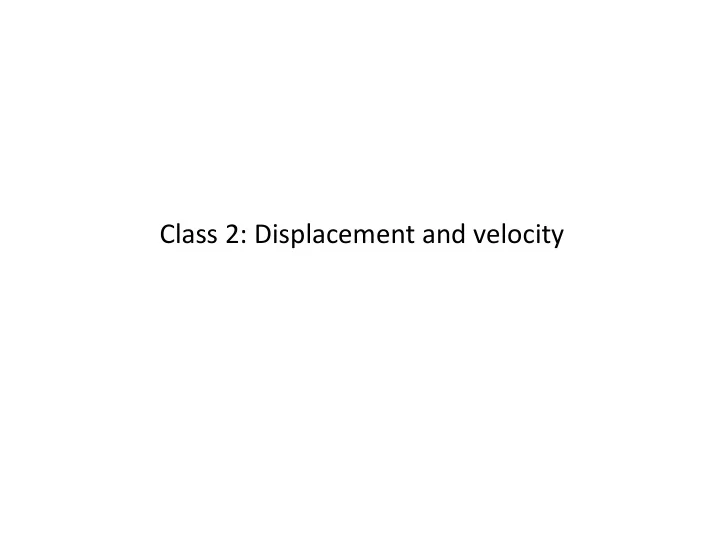

Class 2: Displacement and velocity
Metric system Units can be modified by a prefix. Common prefixes: e.g. millimeter = 10 -3 m m (milli) = ×10 -3 e.g. microgram = 10 -6 g (micro) = ×10 -6 e.g. nanometer = 10 -9 m n (nano) = ×10 -9 e.g. picosecond = 10 -12 s p (pico) = ×10 -12 Sean Mauch -- e.g. kilogram = 10 3 g K (kilo) = ×10 3 e.g. Megaton = 10 6 ton M (Mega) = ×10 6 e.g. Gigabyte = 10 9 byte G (Giga) = ×10 9 Should be Tera T (Tetra) = ×10 12 Note: SI units of mass is kg, or kilogram, equals to 10 3 g. Gram (g) is not an SI units.
Coordinates (1D) 4m 5m 2m 3m -4m -3m 1m -5m -2m -1m 0 x i = -2m x f = +4m i f x f = -3m x i = +3m 5m 4m 3m 2m 1m -4m 0 -1m -2m -3m -5m It is important to define the direction and origin (0) of the axis which the coordinate refers to.
Displacement x (1D) 4m 5m 2m 3m -4m -3m 1m -5m -2m -1m 0 x= x f - x i = +4-(-2) = +6m x i = -2m x f = +4m i f x= x f - x i = -3-(3) = -6m x i = +3m x f = -3m 5m 4m 3m 2m 1m -4m 0 -1m -2m -3m -5m
Displacement x and distance d (1D) 4m 5m 2m 3m -4m -3m 1m -5m -2m -1m 0 x= x f - x i = +4-(-2) = +6m d = 6m x i = -2m x f = +4m i f x= x f - x i = -3-(3) = -6m x f = -3m x i = +3m d = 6m 5m 4m 3m 2m -4m 1m 0 -1m -2m -3m -5m d = | x| if there is no U-turn 4m 5m 2m 3m -4m 1m -3m -2m -1m 0 -5m x= x f - x i = +4-(-2) = +6m d = 8m x i = -2m x f = +4m i f x= x f - x i = -3-(3) = -6m x f = -3m x i = +3m d = 8m 5m 4m 3m 2m 1m -3m -4m 0 -1m -2m -5m d | x| if there is U-turn
Average velocity and average speed (1D) 4m 5m 2m 3m -4m 1m -3m -2m -1m 0 -5m x= x f - x i = +4-(-2) = +6m d = 8m x i = -2m x f = +4m at t i at t f x= x f - x i = -3-(3) = -6m x f = -3m x i = +3m d = 8m 5m 4m 3m 2m -4m 1m -3m 0 -1m -2m -5m x x x f i Average velovcity t t t f i d d Average speed t t t f i Average speed = |average velocity| if there is no U ‐ turn Average speed |average velocity| if there is U ‐ turn
Instantaneous velocity and Instantaneous speed (1D) x Instantaneous velocity v Lim Average velovcity Lim x t t 0 t 0 dx dt d Instantaneous speed Lim Average speed Lim t t 0 t 0 1. In mechanics, only instantaneous velocity and speed are important. Average velocity and speed are just introduced to define their instantaneous values. So from now on, by velocity or speed, we mean instantaneous velocity and instantaneous speed. 2. When t 0, no U ‐ turn is possible. So instantaneous speed = |instantaneous velocity| always. For this reason, we will just write speed as |v x |. The absolute sign is now called magnitude, speed is the magnitude of velocity (note I am beginning to drop the adjective instantaneous).
x ‐ t graph U-turning. Stop x (position) instantaneously. Moving in the negative axis direction t (time) U-turning. Stop instantaneously. Moving in the positive dx axis direction v x slope of curve dt
Preparation for next class Read 2.4 2 d x a Eq. (2.12) x 2 d t dv Not in text, but that v doesn’t mean it is dx not important Try to convince yourself displacement x, velocity dx/dt, and acceleration d 2 x/dt 2 are independent of each other – you can not tell one from the other. They can have different signs (8 possible combinations), practice and think how the motion looks like for some of these combinations. For example, try to produce the motion with a pencil on a real number line if x is negative, v is positive, a is negative.
Recommend
More recommend